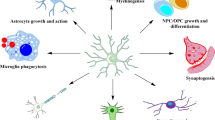Abstract
Metabotropic glutamate receptors (mGluRs) may play a role in modulating microglial activation, but group I mGluRs have received little attention. This study aimed to investigate the effects of group I mGluR selective ligands, (S)-3,5-dihydroxyphenylglycine ((S)-3,5-DHPG) and (RS)-1-aminoindan-1,5-dicarboxylic acid (AIDA), in lipopolysaccharide (LPS; 50 ng/ml)-activated rat microglial cultures. (S)-3,5-DHPG (150 μM) significantly reduced (approximately 20–60%) the LPS-mediated production of nitrite (NO2 −), tumour necrosis factor alpha (TNF-α), and l-glutamate (Glu) at 24 and 72 h. Image analysis revealed increases in both cell area and number, with larger amoeboid microglia (with retracted processes) formed following 2 h LPS exposure. This cellular population was absent after addition of (S)-3,5-DHPG, an effect antagonised by AIDA, and a concomitant reduction in cell area was also found. Taken together, these biochemical and morphological observations suggest that (S)-3,5-DHPG reduces microglial activation, indicating a role for group I mGluRs in modulating microglial function.


Similar content being viewed by others
References
Hanisch UK, Kettenmann H (2007) Microglia: active sensor and versatile effector cells in the normal and pathologic brain. Nat Neurosci 10:1387–1394. doi:10.1038/nn1997
Schwab C, McGeer PL (2008) Inflammatory aspects of Alzheimer disease and other neurodegenerative disorders. J Alzheimers Dis 13:359–369
Garden GA, Moller T (2006) Microglia biology in health and disease. J Neuroimmune Pharmacol 1:127–137. doi:10.1007/s11481-006-9015-5
Pocock JM, Kettenmann H (2007) Neurotransmitter receptors on microglia. Trends Neurosci 30:527–535. doi:10.1016/j.tins.2007.07.007
Block ML, Zecca L, Hong JS (2007) Microglia-mediated neurotoxicity: uncovering the molecular mechanisms. Nat Rev Neurosci 8:57–69. doi:10.1038/nrn2038
Matute CM, Domercq M, Sanchez-Gomez MV (2006) Glutamate-mediated glial injury: mechanisms and clinical importance. Glia 53:212–224. doi:10.1002/glia.20275
Schoepp DD (2001) Unveiling the functions of presynaptic metabotropic glutamate receptors in the central nervous system. J Pharmacol Exp Ther 299:12–20
Conn PJ, Pin JP (1997) Pharmacology and functions of metabotropic glutamate receptors. Annu Rev Pharmacol Toxicol 37:205–237. doi:10.1146/annurev.pharmtox.37.1.205
Cartmell J, Schoepp DD (2000) Regulation of neurotransmitter release by metabotropic glutamate receptors. J Neurochem 75:889–907. doi:10.1046/j.1471-4159.2000.0750889.x
D’Antoni S, Berretta A, Bonaccorso CM et al (2008) Metabotropic glutamate receptors in glial cells. Neurochem Res 33:2436–2443. doi:10.1007/s11064-008-9694-9
Verkhratsky A, Kirchhoff F (2007) Glutamate-mediated neuronal-glial transmission. J Anat 210:651–660. doi:10.1111/j.1469-7580.2007.00734.x
Byrnes KR, Stoica B, Loane DJ et al (2009) Metabotropic glutamate receptor 5 activation inhibits microglial associated inflammation and neurotoxicity. Glia 57:550–560. doi:10.1002/glia.20783
Taylor DL, Diemel LT, Cuzner ML et al (2002) Activation of group II metabotropic glutamate receptors underlies microglial reactivity and neurotoxicity following stimulation with chromogranin A, a peptide up-regulated in Alzheimer’s disease. J Neurochem 82:1179–1191. doi:10.1046/j.1471-4159.2002.01062.x
Taylor DL, Diemel LT, Pocock JM (2003) Activation of group III metabotropic glutamate receptors protects neurones against microglial neurotoxicity. J Neurosci 23:2150–2160
Biber K, Laurie DJ, Berthele A et al (1999) Expression and signalling of group I metabotropic glutamate receptors in astrocytes and microglia. J Neurochem 72:1671–1680. doi:10.1046/j.1471-4159.1999.721671.x
Geurts JJ, Wolswijk G, Bo L et al (2003) Altered expression patterns of group I and II metabotropic glutamate receptors in multiple sclerosis. Brain 126:1755–1766. doi:10.1093/brain/awg179
Schoepp DD, Goldsworthy J, Johnson BG et al (1994) 3-5-dihydroxyphenylglycine is a highly selective agonist for phosphoinositide-linked metabotropic glutamate receptors in the rat hippocampus. J Neurochem 63:769–772
Farso MC, O’Shea RD, Jarrott B et al (2008) Group I mGluRs reduce the activation profile of lipopolysaccharide-exposed microglial cultures. Neuropharmacology 55:595
O’Shea RD, Lau CL, Farso MC et al (2006) Effects of lipopolysaccharide on glial phenotype and activity of glutamate transporters: evidence for delayed up-regulation and redistribution of GLT-1. Neurochem Int 48:604–610
Ankarcrona M, Dypbukt JM, Bonfoco E et al (1995) Glutamate-induced neuronal death: a succession of necrosis or apoptosis depending on mitochondrial function. Neuron 15:961–973. doi:10.1016/0896-6273(95)90186-8
Kong LY, Wilson BC, McMillian MK et al (1996) The effects of HIV-1 envelope protein gp120 on the production of nitric oxide and proinflammatory cytokines in mixed glial cell cultures. Cell Immunol 172:77–83. doi:10.1006/cimm.1996.0217
Ong WY, Balcar VJ (1997) Group I metabotropic glutamate receptor agonist causes neurodegeneration in rat hippocampus. J Hirnforsch 38:317–322
Rock RB, Peterson PK (2006) Microglia as a pharmacological target in infectious and inflammatory diseases of the brain. J Neuroimmune Pharmacol 1:117–126. doi:10.1007/s11481-006-9012-8
Hanisch UK (2002) Microglia as a source and target of cytokines. Glia 40:140–155. doi:10.1002/glia.10161
Bezzi P, Domercq M, Brambilla L et al (2001) CXCR4-activated astrocyte glutamate release via TNFalpha: amplification by microglia triggers neurotoxicity. Nat Neurosci 4:702–710. doi:10.1038/89490
Chao CC, Hu S, Molitor TW et al (1992) Activated microglia mediate neuronal cell injury via a nitric oxide mechanism. J Immunol 149:2736–2741
Eskes C, Juillerat-Jeanneret L, Leuba G et al (2003) Involvement of microglia-neuron interactions in the tumor necrosis factor-alpha release, microglial activation, and neurodegeneration induced by trimethyltin. J Neurosci Res 71:583–590. doi:10.1002/jnr.10508
Gibbons HM, Dragunow M (2006) Microglia induce neural cell death via a proximity-dependent mechanism involving nitric oxide. Brain Res 1084:1–15. doi:10.1016/j.brainres.2006.02.032
Piani D, Frei K, Do KQ (1991) Murine brain macrophages induced NMDA receptor mediated neurotoxicity in vitro by secreting glutamate. Neurosci Lett 133:159–162. doi:10.1016/0304-3940(91)90559-C
Piani D, Spranger M, Frei K (1992) Macrophage-induced cytotoxicity of N-methyl-d-aspartate receptor positive neurons involves excitatory amino acids rather than reactive oxygen intermediates and cytokines. Eur J Immunol 22:2429–2436. doi:10.1002/eji.1830220936
Abd-el-Basset E, Fedoroff S (1995) Effect of bacterial wall lipopolysaccharide (LPS) on morphology, motility, and cytoskeletal organization of microglia in cultures. J Neurosci Res 41:222–237. doi:10.1002/jnr.490410210
Attucci S, Clodfelter GV, Thibault O et al (2002) Group I metabotropic glutamate receptor inhibition selectively blocks a prolonged Ca2+ elevation associated with age-dependent excitotoxicity. Neuroscience 112:183–194. doi:10.1016/S0306-4522(02)00002-7
Strasser U, Lobner D, Behrens MM et al (1998) Antagonists for group I mGluRs attenuate excitotoxic neuronal death in cortical cultures. Eur J NeuroSci 10:2848–2855. doi:10.1111/j.1460-9568.1998.00291.x
Jiang-Shieh YF, Yeh KY, Wei IH (2005) Responses of microglia in vitro to the gram-positive bacterial component, lipoteichoic acid. J Neurosci Res 82:515–524. doi:10.1002/jnr.20663
Acknowledgments
Supported in part by a Program Grant from the NH&MRC (Australia) of which PMB is a Research Fellow.
Author information
Authors and Affiliations
Corresponding author
Rights and permissions
About this article
Cite this article
Farso, M.C., O’Shea, R.D. & Beart, P.M. Evidence Group I mGluR Drugs Modulate the Activation Profile of Lipopolysaccharide-Exposed Microglia in Culture. Neurochem Res 34, 1721–1728 (2009). https://doi.org/10.1007/s11064-009-9999-3
Received:
Accepted:
Published:
Issue Date:
DOI: https://doi.org/10.1007/s11064-009-9999-3




